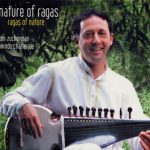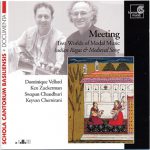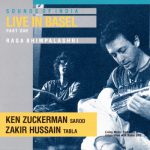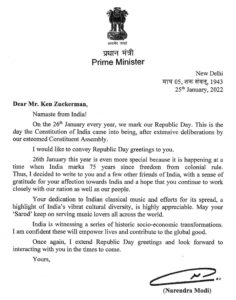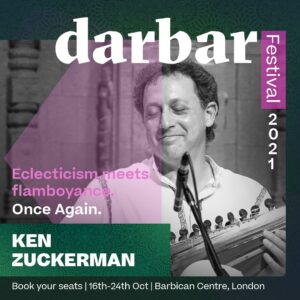“Ken Zuckerman’s selection was the pentatonic Raga Durga. His alap-jor was all it should have been, with the raga building up gradual by tier. There were long, smooth, effortless glides and malleable meends. The alap was reposeful, tranquil, and the result of deep, thoughtful playing, The gat in jhaptala was the forum for Ken to display his profound grasp of both swara and laya. The five notes were varied infinitely in a staggering range of permutations and combinations, peppered liberally with interesting tabla solos. The tricky teentala gat had taankari as its focal point, with the jhala at supersonic speed.”
– Bandana Malhotra, Hindustan Times, Feb.2, 1996
North Indian classical music is one of the most highly developed art music’s in the world. Partaking strongly of improvisational elements, the structural framework of the music is provided by a system of melodic patterns called ragas and of rhythmic patterns called talas. Within the framework, the performers must create the musical fabric at the moment of performance.
Following tradition, the musician doesn’t perform a set program, but rather plays different ragas as inspired at the moment. The choice of raga is not usually a matter of whimsy: in accordance with centuries old philosophical traditions, certain ragas are considered to be appropriate to specific times, seasons of the year, and even states of mind.
Ragas are not to be confused with the Western notion of “scales”, for while each raga has a characteristic pitch structure, much more is implied. The order in which the notes of the raga are introduced, and the manner in which the raga itself is revealed and unfolded are all extremely important. So, also, are matters of ornamentation, pitch alteration, and melodic structure. Historiclly speaking, one actually finds a close correlation between the concept of raga and the early western western church modes.
Although notational systems exist, the tradition is largely an oral one, passed on by each master to students. Performances are appreciated by the audiences in many of the same ways as jazz improvisations: that is, performers are expected to demonstrate extensive knowledge of the traditions of the individual raga (in the same way a jazz musician is expected to know “the changes”). Nonetheless, in both traditions, the performer is admired when able to cast some new light on the familiar: it is the ability to honor the integrity of the raga while doing so in an intensely personal way that wins the greatest esteem.
Form
The basic form for the interpretation of a raga is made up of four parts, ALAP, JOD, JHALA and GAT .
Alap
This is a slow introduction where the performer contemplates the raga note by note, composing phrases, at first quite simply, with the two or three notes nearest the tonic, but gradually becoming more and more complex as he extends through the first octave and then later, over the whole range of the instrument. The alap is performed “ad libitum” rather like a Western cadenza, deriving momentum from the emphasis in the developing phrases. Much use is made of microtonal inflections, ornamentation and glissando. The artist, through his use of these means of expression, reveals his understanding of and sensitivity to the raga he is playing. A truly creative musician is always trying to draw out of a raga some hitherto unseen facet, by way of his improvisation.
Jod / Jor
When the artist feels that he has completed his exposition of the raga through the alap he introduces a rhythmic pulse in to the music, starting again by playing short phrases against his regular striking of the drone strings. As the rhythmic dimension enters the music, the improvisations become more and more extended, eventually with very fast staccato passages called “tans”, full of rhythmic subtlety and requiring considerable technical virtuosity. After several stages of increasing the tempo, the performer can either finish this section or go on to one final movement.
Jhala
Jhala is a section where the artist performs a variety of virtuosic rhythmic patterns utilizing the “chikari” strings (high pitched drone strings). Depending on the performance, the jhala can either be the culmination of the first part (without tabla accompainment), and/or the climax of the “gat” portion.
Gat
This movement is really in “Rondo” form with the main subject being a previously composed motif (usually traditional), which is set to a recurring rhythmic cycle called a “Tal”. The tabla player, whose main function is to mark this “Tal”, accompanies the melody instrument to the end of the performance. As with the western Rondo where the main theme returns after each variation, the Indian performer, having improvised for a few cycles will return either to the beginning of the theme, or to the first beat (the “Sum”) of the new cycle (not necessarily the same). The theme, or “gat”, also serves as a time keeping pattern and the main performer may repeat the gat for several cycles while the tabla player improvises. Actually, it is usual for this whole movement to consist of two gats, one slow and one fast. Near the end of the performance the melody instrument makes a transition into jhala again to bring the performance to a climax.
Tala
Talas are the rhythmic frameworks around which Indian music is composed and improvised. Each tala has a constant number of beats, organized into phrases. Sometimes the phrases are equally divided (ie. Teental, 4-4-4-4), and sometimes they are of unequal lengths (ie. Dhammar 5-2-3-4). Both soloist and accompanist are required to always be aware of the returning of the first beat of the tala. Although in the midst of a composition or improvisation it is permitted (and even encouraged), to emphasize beats and phrases contrary to the framework of the tala, all variations must eventually return to the first beat of the cycle. This moment of return provides much of the exitement of Indian music and gives the musicians extensive scope to show their virtuosity and creativity.
Knowledgable audiences, both in India and the West, are able to follow the movements of the talas and thus, have an increased awareness and appreciation for the musicians’ ability to artistically develop their improvisations within the structures of the rhythmic cycles and return to the first beat. But even uninitiated listeners can sense the moments of rhythmic and melodic return, where all the elements seem to meet again. Many times these moments bring an added thrill to the music and along with it, even spontaneous applause from both experienced and first-time listeners alike.
Some of the more common talas:
TEENTAL
16 beats, 4-4-4-4
DHAMMAR TAL
14 beats, 5-2-3-4
JHAPTAL
10 beats, 2-3-2-3
EKTAL
12 beats, 2-2-2-2-2-2
RUPAK TAL
7 beats, 3-2-2
CHACHAR
4 beats, 3-4-3-4
KEHARWA
8 beats, 4-4
DADRA
6 beats, 3-3

